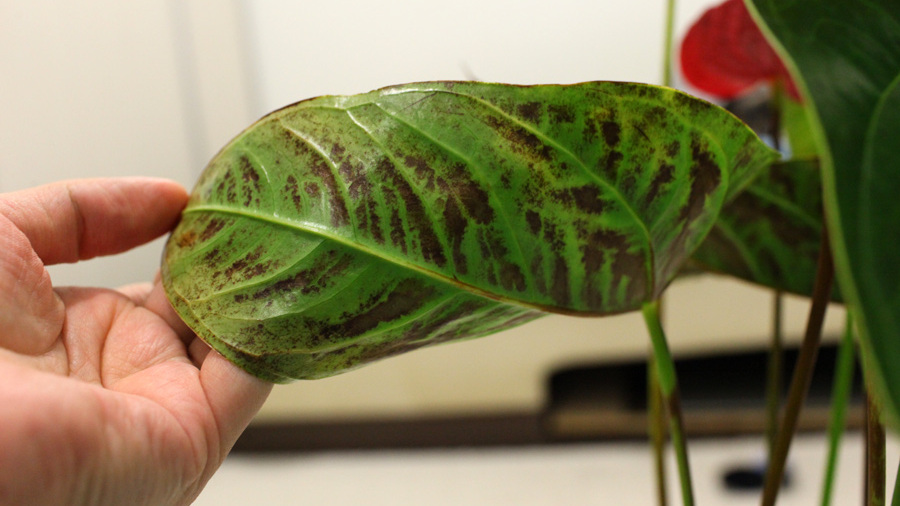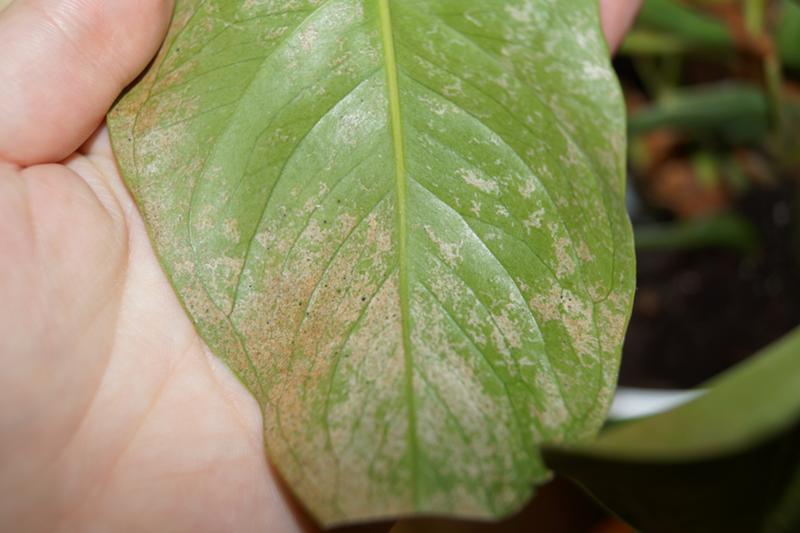Anthurium has brown spots on the leaves - causes and treatment
Content: [Hide]
The plant anthurium (Anthurium) has another unusual popular name - "male happiness". In a healthy state, the flower is literally decorated with beautiful and evenly colored leaves. Their green color should not have any blotches or yellow spots. Due to the intensive growth of this species, the leaves can be quickly renewed.
Why does the flower "male happiness" have brown spots on the leaves?
Most often, brown spots on the leaves of anthurium appear due to non-compliance with the rules of care. If you study all the individual characteristics and "whims" of the plant, you can easily achieve the maximum decorative appearance.
There are several reasons why anthurium leaves can turn brown:
- Improperly organized watering of the plant.
- Late application of top dressing to the soil.
- Very dry air in the room where "male happiness" grows.
- Failure to comply with the length of the "daylight hours".
- A sharp cold snap.
Failure to follow the rules of care can lead to rotting of the roots and the rapid spread of the fungus. The plant can also become covered with specks due to the attack of pests.
Overflow
For this species, it is extremely important to comply with watering rates. An excess of moisture, as well as a lack, will certainly entail anthurium diseases. Frequent and non-standardized watering will lead to root rot.
Brown spots may appear on the leaves if liquid spills on the plate itself. If you do not respond to the problem in a timely manner, this can lead to the death of the entire green part of the plant.
Watering with cold water
For anthurium, the use of cold running water is detrimental. The chlorine contained in it instantly leads to root damage.
It is recommended to water the flower with warm water, settled for 2 days.
Unsuitable soil
Thanks to high-quality soil, the plant is nourished. Anthurium loves nutritious soil. It is very easy to cook it yourself. To do this, you need to mix the ingredients in the following proportions (2: 1: 1: 0.5):
- humus;
- leafy land;
- peat substrate;
- river sand.
Low room temperature
A low temperature can only be harmful if the anthurium is kept in such a room for a long time. Short-term drops are not dangerous.
Failure to comply with the temperature regime leads to damage and decay of the roots. The leaves turn yellow and dry completely. The flower stops developing and dies. For salvation, it is necessary to create the right conditions and carry out the necessary treatment.
Root damage
Inadvertent damage to the root system can occur during transplantation.Because of this, black spots appear on the flower. The event must be carried out as carefully as possible - by the transshipment method.
Even if the root shoots were accidentally broken or damaged, they must be treated with manganese and sprinkled with charcoal before being lowered into the ground.
Sunburn
A change in the color of the foliage may indicate the choice of the wrong place for the anthurium. Placing a plant on a southern windowsill can cause sunburn. Their appearance is characterized by yellowing and curling of the foliage.
To save the flower, it must be rearranged to the shaded area of the house.
Defeat with septoria
This disease develops as a consequence of fungal damage. If no treatment is taken, the spots will grow fairly quickly. With a protracted illness, the leaves turn black completely.
Treat this infection urgently. For this, treatment with Fitosporin or 1% Bordeaux liquid is carried out.
Aphid attack
The parasitic aphid lives on the leaves and sucks the juice out of them. Therefore, the leaf plates curl and become sticky. In the absence of proper treatment, the flower quickly dies.
For the treatment of anthurium, it is necessary to wash it with soapy water, and then pour it over with manganese or Fitosporin.
Scabbard attack
What to do if brown spots appeared on the leaves of anthurium due to an attack of scale insects? The first signs of an attack of these particular insects are pronounced white or yellow tubercles.
Most often, they appear on the leaves, and only then cover all the green parts of the flower. The scale insect feeds on the sap of the plant and because of this, the leaves begin to dry and tear. For treatment, it is recommended to use any fungicidal preparations.
What to do if the leaves of anthurium are covered with brown spots
After the appearance of the first external signs, it is necessary to urgently carry out resuscitation measures:
- Urgent correction of soil and air moisture. The plant does not tolerate overflows, but it can also get sick from lack of water.
- If a change in the color of the leaves occurred during the heating period, then the level of air humidity must be increased. This can be achieved by installing a tray with water next to the anthurium.
- Frequent overflows can lead to root rot. You can save a flower by transplanting it into a new soil. Before deepening, all damaged or diseased parts of the root system should be removed.
- The use of chlorinated water can also lead to plant diseases.
- The introduction of mineral preparations into the soil will help the flowering species to cope with this stress more easily.
- If the feeding rate is exceeded, the fertilization process should be stopped urgently and the excess should be “washed out” with purified water.
Timely adjustments and changes in the rules of care will quickly save the flower and prevent repeated damage to the species.
What other spots can appear on anthurium and why
The appearance of uncharacteristic spots on the leaves of anthurium indicates a disease of the species. It is possible to understand the reason and decide on the treatment only after a thorough examination of the leaf plate.
Yellow spots
Yellowing of the leaf plate can occur when the plant is infected with chlorosis. It appears due to a lack of the following trace elements: iron and magnesium. For treatment, the damaged leaves should be removed and a complex fertilizer enriched with the necessary substances should be urgently introduced into the soil.
Black spots
If the transplant procedure was carried out incorrectly or an unsuitable substrate for this type of substrate was used, black spots may appear on the anthurium.
The soil for this species is selected taking into account the individual preferences of the plant. For example, intended for bromeliads or orchids.
White spots
When anthurium is infected with powdery mildew, a white bloom appears on the leaves.
This disease occurs at high temperatures and high humidity in the room.
This disease is easily treated in the early stages with common fungicides.
How to properly care for anthurium to avoid brown spots
Due to the fact that, to a greater extent, the color change of the leaf occurs due to improper care, the implementation of the following instructions will preserve the health of the cultivated plant:
- It is recommended to choose a shaded place for growing anthurium. The flower reacts painfully to the bright sun. In winter, it is important to install additional light for the plant.
- The optimum temperature should vary within +25 degrees. In winter, it is allowed to lower it to +14 degrees.
- "Man's happiness" does not tolerate drafts and strong gusts of wind.
- It is important to follow the rules for watering anthurium.
- Dry air is detrimental to this species. You need to spray the air, not the flower itself.
- Fertilizing the soil is carried out twice a month. During the active growing season, the feeding rate should be increased.
- After purchasing a flower, it must be transplanted from a shipping container. At this stage, it is important to give the plant "rest" and wait for the adaptation period.
The appearance of brown spots on the plant almost always signals a violation in the cultivation and care of the anthurium. With the correct content and timely implementation of preventive measures, anthurium will delight you with its grace for many years.
























